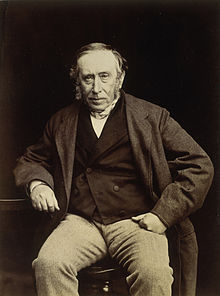James Syme
James Syme (born November 7, 1799 in Edinburgh , † June 26, 1870 in Millbank House near Edinburgh) was a Scottish surgeon.
Life
Syme was the son of a landowner in Fifeshire . He studied from 1814 at the University of Edinburgh , first botany and other subjects. From 1817 he turned to medicine and became a student of the surgeon John Barclay (1758-1826) at a non-university ( extramural ) school of surgeons. He continued to work intensively on chemistry, discovered a solvent for rubber in the tar distillate and thus invented a waterproof textile paint that could be dissolved in rubber. The Scottish chemist Charles Macintosh heard about it in Glasgow, developed this waterproof material further and patented it, which resulted in the Mackintosh raincoat.
Syme never received a formal medical degree. In 1818/19 he became assistant and demonstrator (prosector) for anatomy with Robert Liston (his cousin) in his private school, who in 1823 left him teaching anatomy entirely. Since Liston was still involved financially, conflicts arose, which from 1823 onwards led to an opposition with his former teacher. At the same time he was a surgeon at various hospitals in Edinburgh. In 1820 he became chief physician (Medical Surveyor) at the Fever Hospital in Edinburgh, where he fell ill with typhus himself , in 1822 he became a surgeon (House Surgeon) at the Royal Infirmary and in 1822 he became a member and in 1823 a fellow of the Royal College of Surgeons of Edinburgh . In 1825 he founded his own school for medicine (Brown Square School of Medicine), but got into an argument with his partners because he wanted to concentrate on surgery. He did this very successfully in his own private teaching hospital Minto House from 1829 to 1833. In 1833 he was appointed as the successor to James Russell (1755-1836) Regius Professor of Clinical Surgery at the University of Edinburgh. There he operated on in the lecture hall in front of the students and made sure right from the start that he could accept his own patients. He also insisted that all medical students attend lectures in surgery. After Liston went to London in 1835, Syme was the leading surgeon in Scotland and he also succeeded him as a surgeon at the Royal Infirmary. He stayed on his professorship in Edinburgh except for a short stay in London from February to July 1848 as Liston's successor at University College. He also got into an argument with colleagues there and returned to his old chair in Edinburgh. In 1869 he had a seizure that partially paralyzed him and forced him to give up his chair.
In 1830 he was elected a member of the Royal Society of Edinburgh .
From 1849 he pursued a reform of medical training in Great Britain on the model of Edinburgh, in which he was also successful in 1858 with the adoption of an official state guideline.
Syme is known for a technique of amputation of the foot, named after him, which he first performed in 1823. Syme was also known for more daring operations in the early 19th century. However, he tried to remove as little tissue as possible and also tried reconstructive plastic surgery early on. Among the leading surgeons at the time (with Nikolai Ivanovich Pirogow ) he was one of the early proponents of the use of ether for anesthesia in the 1840s . He also adopted the antiseptic methods of his son-in-law Joseph Lister at an early age .
His daughter married Joseph Lister in 1855, who was his assistant (House Surgeon) from 1853 and one of the few people with whom he never started a fight.
Fonts (selection)
- Case of osteo-sarcoma of the lower jaw, 1828
- A Treatise on the Excision of Diseased Joints, 1831
- Principles of Surgery, 1831
- Diseases of the Rectum, 1838
- On the use of ether in the performance of surgical operations, 1847/1848
- Stricture of the Urethra and Fistula in Perineo, 1849
- Excision of the Scapula, 1864
- Contributions to the Pathology and Practice of Surgery, 1848 (collection of articles)
- Observations in Clinical Surgery, 1861.
- Case of iliac aneurism, 1862
literature
- Robert Paterson Memorials of the Life of James Symon , Edinburgh 1874, online
- Barbara I. Tshisuaka: Syme, James. In: Werner E. Gerabek , Gundolf Keil u. a. (Ed.): Encyclopedia of medical history. De Gruyter, Berlin / New York 2005, ISBN 3-11-015714-4 , p. 1371.
Web links
Individual evidence
- ↑ Since most of the corpses available for anatomy ended up with Barclay or Alexander Munro from the well-known medical dynasty in Edinburgh, Liston and Syme were also forced to use illegal methods of procuring corpses in cemeteries
- ↑ For this reason he was not given a leading position as a surgeon at the Royal Infirmary, as there was fear that the conflict would be carried to the hospital. They were not reconciled until 1840.
- ↑ He and his partner John Mackintosh also taught anatomy, but again had problems getting enough corpses
- ^ Fellows Directory. Biographical Index: Former RSE Fellows 1783–2002. (PDF file) Royal Society of Edinburgh, accessed April 14, 2020 .
- ^ Syme Amputation, Orthopädie Lexikon
- ^ Biography of Syme
| personal data | |
|---|---|
| SURNAME | Syme, James |
| BRIEF DESCRIPTION | Scottish surgeon |
| DATE OF BIRTH | November 7, 1799 |
| PLACE OF BIRTH | Edinburgh |
| DATE OF DEATH | June 26, 1870 |
| Place of death | Millbank near Edinburgh |
